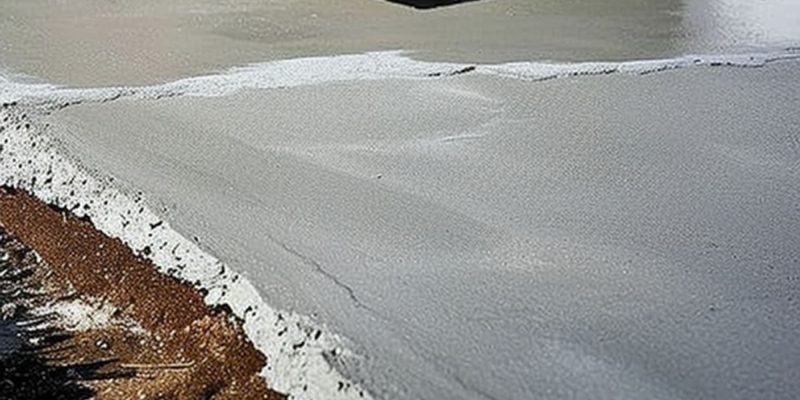Keeping your cement patio in tip-top shape not only boosts your home’s curb appeal but also ensures it’s a safe and enjoyable place for family gatherings. In this guide, we’ll explore the why, how, and when of cement patio repair, offering easy-to-follow advice to keep your outdoor space looking great.
Why Repair Cement Patio?
Enhancing Home’s Beauty
A pristine patio is like the frame of your home’s picture. It adds a touch of elegance and care that reflects your pride in your residence. A well-maintained patio is a testament to a homeowner’s attention to detail and commitment to their home’s aesthetics.
Boosting Property Value
When it comes to real estate, first impressions matter a lot. A repaired and maintained patio can significantly boost your property’s market appeal and value. It’s an investment that not only enhances the immediate usability of your space but also pays dividends if you plan to sell or rent out your property.
Ensuring Safety
Overlooking patio damages can lead to accidents and injuries. Cracked or uneven surfaces are trip hazards, especially for children and the elderly. Timely repairs ensure that your outdoor space is not just beautiful but also safe for everyone to enjoy.
Preventing Further Damage
Small issues can quickly become big problems if not addressed. Regular repairs prevent minor cracks and wear from turning into costly renovations down the line. It’s akin to fixing a leaky roof before it damages the entire house.
Maintaining Functionality
Your patio is an extension of your living space. Keeping it in good repair means you can continue hosting barbecues, relax on summer evenings, and enjoy the outdoor ambiance that Rockford offers. A well-maintained patio is always ready for impromptu gatherings or a quiet morning coffee.
Expanded Common Causes of Patio Damages
Natural Wear and Tear: Just like the changing seasons of Rockford, your patio also goes through a cycle of wear and tear. Repeated exposure to sun, rain, and particularly our freezing winters can cause the concrete to expand and contract. This natural process can lead to cracks and erosion over time. It’s the inevitable battle with the elements that any outdoor surface faces.
Poor Installation Techniques: A patio’s longevity starts right from its installation. If the foundation was not properly prepared or if the concrete mix wasn’t right, issues are bound to surface sooner rather than later. These can manifest as uneven settling, cracking, or even surface flaking, which are more than just cosmetic issues.
Environmental Factors: Apart from weather, factors like tree roots growing underneath the patio or improper drainage around your home can cause damage. Excessive moisture due to poor drainage can weaken the concrete, while roots can push up and crack the surface. It’s a reminder that the environment surrounding your patio plays a crucial role in its health.
Chemical Damage: Sometimes, the culprits are the chemicals we use. De-icing salts, commonly used in Rockford winters, can be harsh on concrete surfaces. They can accelerate the freeze-thaw cycle, leading to surface spalling – where the top layer of the concrete chips away.
Heavy Loads: Your patio might be a robust space, but it has its limits. Heavy objects like large grills, furniture, or even frequent foot traffic in a specific area can stress the concrete. Over time, this can lead to surface indentation, cracking, or pitting.
Understanding these causes is the first step in preventive care and targeted repair. By addressing these factors, you can extend your patio’s lifespan and maintain its beauty and functionality.
Expanded Types of Cement Patio Damages and Ways to Repair Them
- Cracks: Small or hairline cracks are common in patios and often a result of natural settling or the freeze-thaw cycle in Rockford. To repair these, use a concrete crack filler or a caulk-based product. It’s as simple as cleaning the crack, filling it with the product, and smoothing it over. For larger cracks, a concrete patching compound might be necessary. Remember, addressing cracks early on can prevent them from widening and causing more significant issues.
- Discoloration: Over time, your patio may lose its color or develop stains. A weekend project involving a thorough cleaning followed by concrete staining or painting can restore its original look. Choose a stain or paint that’s suitable for outdoor use and concrete surfaces. This not only revives the appearance but also adds a layer of protection.
- Surface Erosion: If your patio surface is worn or eroded, resurfacing might be the answer. This involves applying a new layer of concrete or a concrete overlay on top of the existing surface. It gives your patio a brand-new look without the need to replace the entire slab.
- Crumbling Corners: Corners are prone to chipping and breaking. To fix them, start by cleaning the area, removing any loose material. Then, apply a concrete patching compound, shaping it to match the original corner. It’s important to let it cure properly before using the area.
- Pooling Water: Poor drainage can cause water to pool on your patio, leading to damage over time. To fix this, you may need to adjust the slope of your patio or install a drainage system. This ensures water flows away from the surface, reducing the risk of water-related damage.
- Sunken Slabs: Over time, parts of your patio might sink due to soil erosion or settlement. This can be fixed through a process called mudjacking or slabjacking, where a grout mixture is pumped under the sunken slab to raise it back to its original level.
Repairing your cement patio not only involves fixing visible damage but also understanding and addressing the underlying causes. By taking a comprehensive approach to repair, you can ensure that your patio remains a beautiful and functional part of your Rockford home for years to come.
Expanded What to Avoid When Repairing Cement Patio
- Ignoring Manufacturer’s Instructions: Each repair product comes with specific instructions for a reason. Neglecting these can lead to improper application, less effective repairs, or even further damage. It’s like using medicine without reading the label – it’s crucial to understand how to use it correctly for the best results.
- Improper Preparation: The success of a repair job starts well before the actual repair. Ensure the area is clean and dry. Remove any debris, dirt, or loose concrete. If you’re applying a new layer or a sealant, not preparing the surface can lead to poor adhesion and longevity of the repair. It’s similar to painting a wall – proper preparation ensures a smooth finish.
- Using Incompatible Materials: Not all repair materials are suitable for every type of damage or patio. Using the wrong type can cause more harm than good. It’s like using a band-aid on a fracture – you need the right solution for the specific problem.
- Rushing the Process: Patience is key in repair work. Allow adequate time for the repair material to set and cure. Rushing through the process or using the patio before it’s ready can undo all your hard work.
Overloading with Heavy Objects: After a repair, give your patio time to fully recover before placing heavy objects on it. Overloading a freshly repaired patio can lead to immediate damage.
Avoiding these common pitfalls will help ensure that your repair work is successful and lasting. Remember, a well-executed repair not only improves the appearance of your patio but also extends its lifespan.
Expanded When to Consult an Expert
Complex Repairs: If you’re facing significant damage like deep cracks, major erosion, or structural issues, it’s time to call in the pros. These issues often require specialized knowledge and tools that go beyond typical DIY skills. An expert can assess the situation accurately and offer the most effective solutions.
Structural Concerns: If there’s any suspicion that the patio’s structural integrity is compromised, don’t hesitate to seek professional advice. This could include signs like large, widening cracks, or areas where the concrete has sunk significantly. These issues can be symptomatic of deeper problems that need professional assessment.
Quality Assurance: Even if you’re handy, there are times when getting a professional’s touch can ensure the job is done right the first time. They can also provide warranties for their work, giving you peace of mind.
Concrete Patio Repair Tips
Regular Maintenance Tips: Consistent maintenance is the key to prolonging the life of your patio. This includes regular sweeping to remove debris, periodic washing to keep it clean, and sealing every two to three years to protect against weathering and stains. Think of it like routine care for a prized possession – it keeps it looking great and functioning well.
Cost-Effective Repair Solutions: For minor damages, DIY repairs can be a budget-friendly option. Simple crack filling or resealing can be done with basic tools and materials. However, for more extensive damages, while DIY might seem cheaper initially, hiring a professional can be more economical in the long run due to the durability and quality of their work.
Expanded FAQs
How often should I inspect and repair my cement patio?
Regular inspections, ideally twice a year, can help catch issues early. Rockford’s seasonal changes can affect your patio, so checking in the spring and fall is a good practice. Repair needs depend on the patio’s condition but addressing issues as soon as they’re spotted is key.
Can I repair my patio in winter?
It’s best to undertake repairs in warmer weather. Below-freezing temperatures can hinder the curing process of repair materials. Plan repairs for when the temperature is consistently above 50°F to ensure proper setting and curing.
What’s the best way to prevent patio damage?
Regular maintenance is crucial. This includes cleaning, sealing cracks and joints, and removing snow and ice carefully in winter. Also, avoid using harsh chemicals like de-icers that can damage concrete.
Is it expensive to repair a cement patio?
The cost can vary depending on the extent of the damage. Small DIY repairs like filling cracks can be quite affordable. However, larger issues like sunken slabs or structural repairs will likely require professional intervention, increasing the cost.
How long do patio repairs last?
If done correctly, most repairs can last several years. The longevity of a repair also depends on the quality of the materials used and the patio’s exposure to wear and tear.
Can I change the color of my patio while repairing it?
Absolutely! Resurfacing or staining your patio during repair is an excellent opportunity to change its color. Just ensure the products used are appropriate for outdoor concrete surfaces.
Should I seal my patio after repairs?
Yes, sealing is highly recommended. It protects the patio from moisture, stains, and weather-related wear. A good quality sealant can extend the life of both your patio and the repairs.
Conclusion
Taking care of your cement patio is a blend of timely repairs, regular maintenance, and knowing when to call in the experts. With these tips, your Rockford home’s patio will continue to be a beautiful, safe space for years to come. Happy repairing, and enjoy your revitalized outdoor haven!

